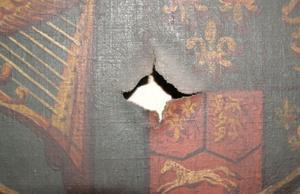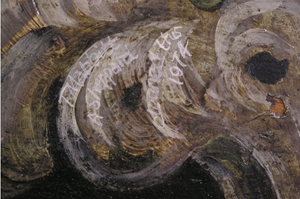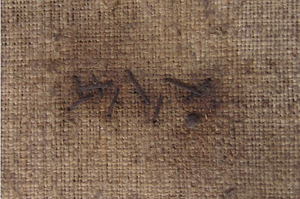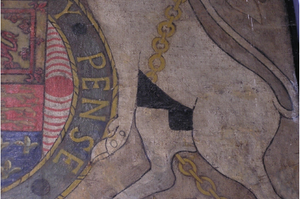Beyond the Environment
Human Damage: Accidental and Deliberate
Human Damage: Accidental and Deliberate

The majority of past damage caused to Royal Arms in churches has been accidental and often stems from neglect or the redundancy of the building.
Once the building is no longer watertight, paintings suffer from damp or from direct contact with rainwater.
Royal Arms are usually located fairly high on the walls or ceiling and are often hung at an ideal angle to catch leaks. Consequently, they are very vulnerable to water damage.
Accidental damage can occur in any number of ways, from minor damage caused by scaffolding poles going through canvases during building works to major damage from building-wide fires or flooding.

There are often risks involved when paintings are relocated: from the separation of paintings and frames to being mistaken for rubbish and discarded. Also the Royal Arms on canvas are particularly vulnerable to vibration in transit and being leant against sharp objects.
Dusters, Restorers, and Roundheads
Damage occurs despite the best of intentions. Even general cleaning and housekeeping can inadvertently hasten deterioration and it is not unusual to find the characteristic yellow fibres from dusters caught in flaking and insecure paint.

Even greater damage can occur as a result of amateur restoration, dangerous in both what it can remove and what it can leave behind:
- Injudicious cleaning may dissolve the paint along with the varnish
- Tear repair can involve crude sewing or glueing
- A wide variety of unsuitable materials, such as wartime black-out curtains, floral upholstery fabric and redundant parish notices, may be stuck onto the reverse of fragile canvases to hold them together
Perhaps most harmful of all is when restoration has simply involved a complete repainting of the arms, sometimes inaccurately rendering details and dates.

Most of the deliberate alteration and destruction of Royal Arms is historical - many suffered damage or obliteration by anti-royalists during the English Civil War. If the arms did survive into the nineteenth century, Victorian church reordering might at best relocate them and at worst remove them entirely.
Partial damage, covering or obliterating the supporting lion and unicorn’s genitals, could occur at any period when the perpetrator chose to be offended. Even in the twentieth century there are accounts of Royal Arms being chopped into kindling or used as flooring.

